The increasing number of cases in Europe is forcing several governments to impose stricter rules, creating a sort of “Lockdown light” or “semi-lockdown”. The aim is to reduce the rate of the new infections and avoid the collapse of the hospital facilities.
In the recent days, Italy and Germany have already presented the new rules to the respective citizens.
The present analysis aims to highlight similarities and differences between the rules imposed by the Italian and German governments.
The following tables are created for different specific (not all) topics and they refer to the information available at 29 October 2020. I want to remark it because, in the next hours, further clarifications or updates might be generated by the respective government and could be not reflected in this article. The color code used for the table has the following explanation: green=no suspension of activities, no additional severe restrictions; yellow= no suspension of activities, but additional restrictions; red=suspension of activities.
Table-1 summarizes general information. Italy announced the new rules on October 24th, while Germany did it in October 28th. The duration of these new rules is more or less the same, about one month. In Italy, this “Lockdown Light” started last Monday, 26th October. In Germany it will start next Monday, 2nd November.
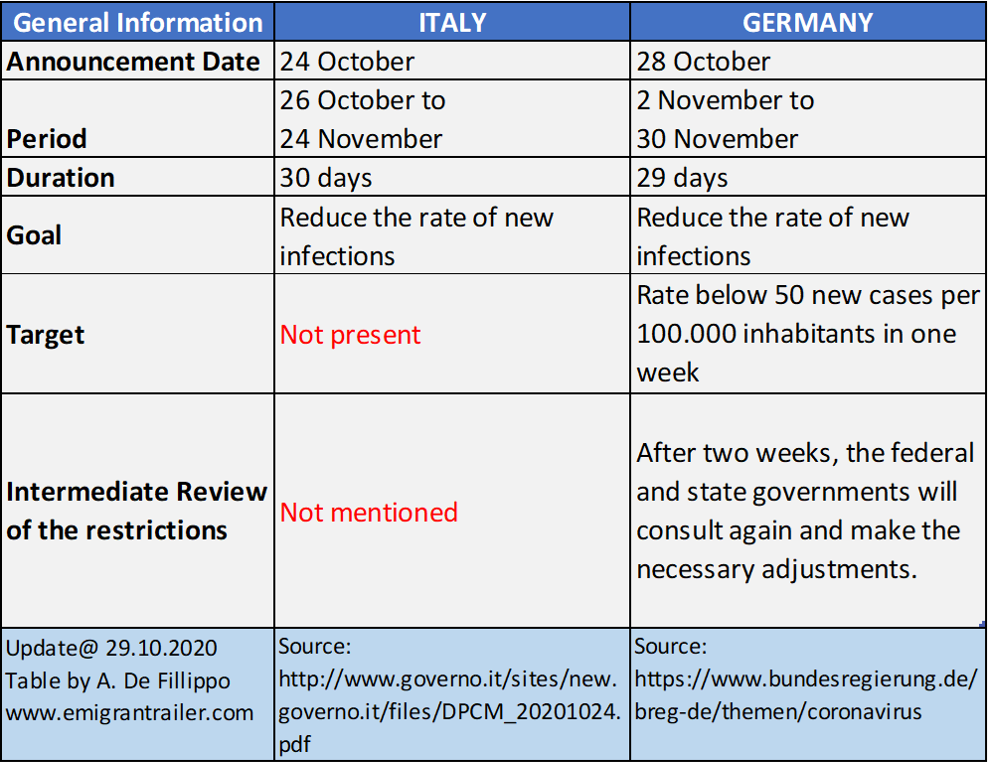
The goal is basically the same: to reduce the rate of the new infections and avoid the collapse of the hospital facilities. There is a big difference for what concern a target to reach with this Light Lockdown and for what concern possible reviews. Italy government has not explicitly declared any of both, while German government aims to bring back the rate of new infections below the already existing target of 50 new infections for 100.000 inhabitants in one week. Moreover, German government has explicitly announced to consul again in two weeks and make the necessary adjustments.
Table-2 summarizes the rules concerning public interactions. Both governments kept possible the staying in public (of course respecting the already existing rules of distance and protective measurements). However, the Italian government does not put a specific limit on the number of people to meet (in Germany is 10) and on the origin of the people (in Germany, either from the same family or maximum two families). On the other hand, in Italy it will be possible to close street and squares where gathering situation can be created after 21.00. There is not similar direction in Germany.
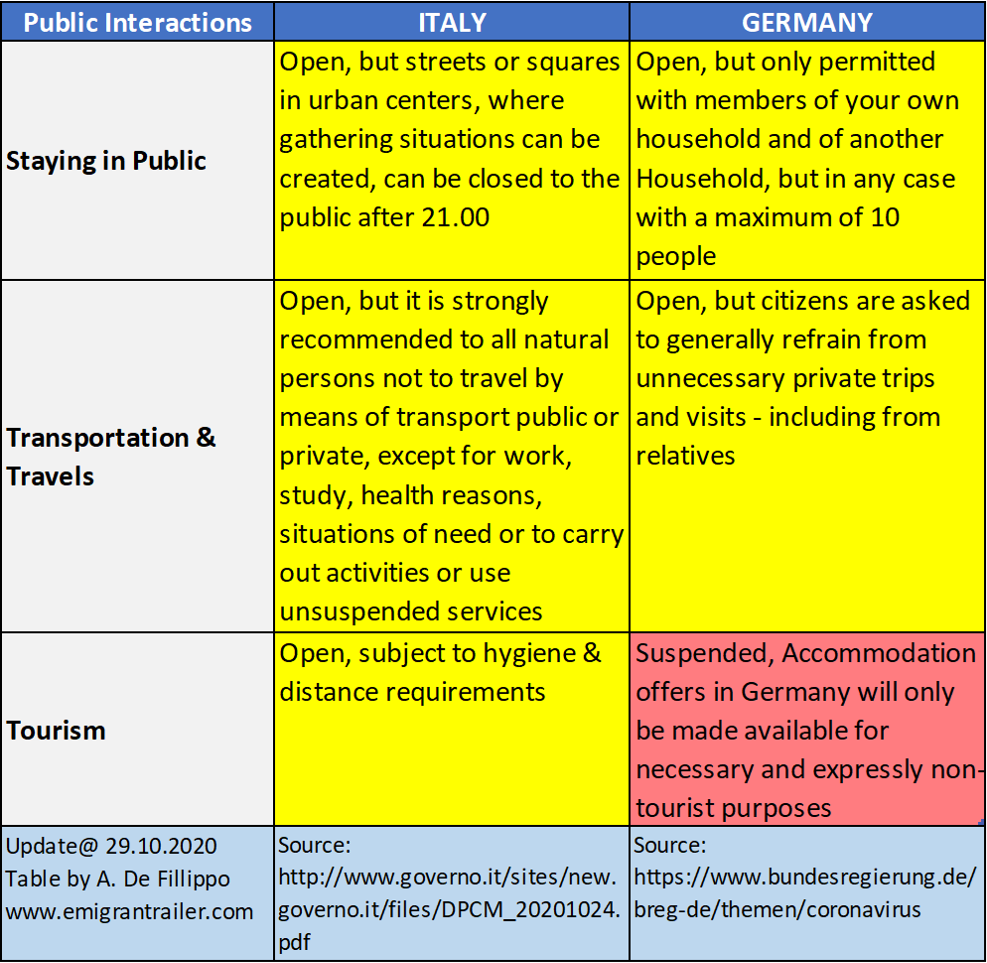
Transportation and travels are not fully restricted in both countries. Both governments ask to each citizen to refrain from unnecessary private trips and travels. In Germany this recommendation is also valid within German borders.
Tourism is treated differently with stricter restriction in Germany, where accommodation offers in Germany will only be made available for necessary and expressly non-tourist purposes.
Table-3 summarizes the situation for events for Culture and Entertainment. All of them are either suspended or prohibited in both countries. The only exception is the access to museums in Italy, which remains open under specific conditions. The German government did not explicitly state anything about museums, but it is assumed that they will be closed.
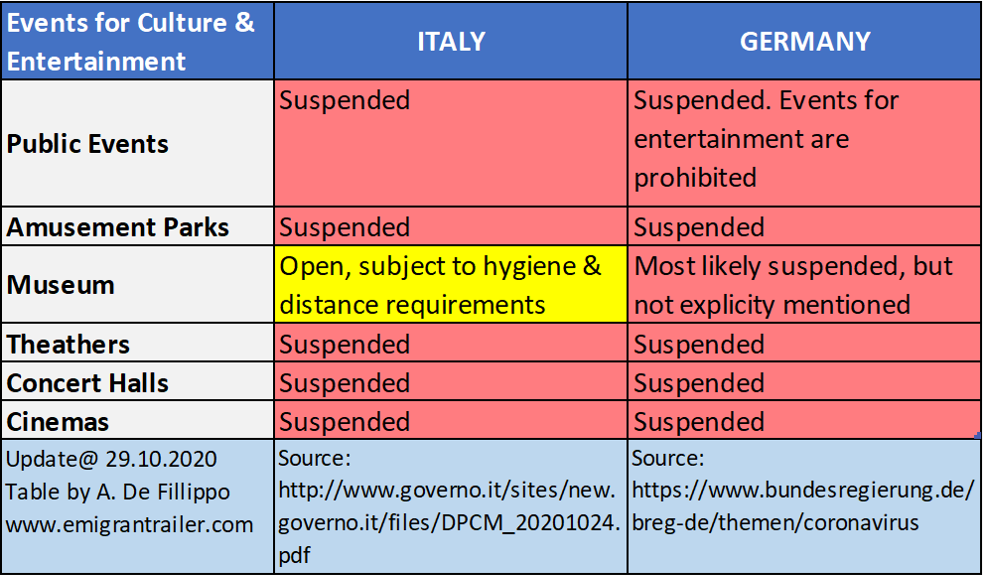
Table-4 summarizes the new rules about sports activities. Both countries suspend all activities in the fitness studios, swimming pools and non-professional sports. Both countries allow professional sports activities, but without any public. Individual sports like running or jogging is allowed but with some basic differences among the two countries. In Italy the main restriction is about the distance of 2 meters, while in Germany it will be possible only alone, in pairs (if from different household) or only with people from the own household. Ski facilities are in general limited in Italy, and open under specific circumstances, either for professional athletes or in case of specific approval by the local authorities and Scientific Technical Committee. As far as I understand, in Germany, there is not yet a specific direction on these activities.
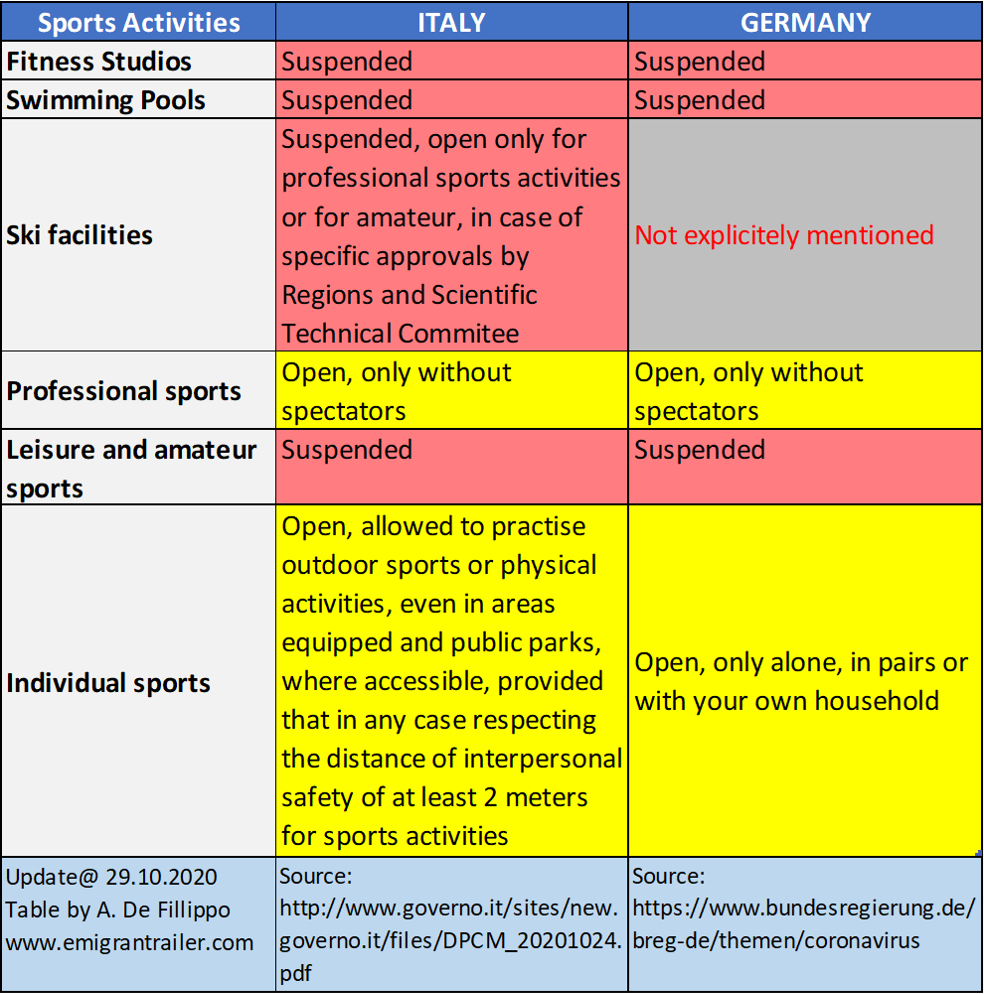
Table 5 shows similar approach for discos, pubs, clubs (suspended in both countries) and for delivery and collection of take-away meals for consumption at home and for canteens (open in both countries). The big difference is about restaurants, bars, ice cream parlors and pastry shops. In Germany the normal activity is suspended. Namely, nobody can consume the food on site at any time during the day. However, these places are allowed to do take-away services. In Italy, there is the possibility to eat on site only between 5 a.m. and 6 p.m., and only with your own household, for a max of 4 people per table.
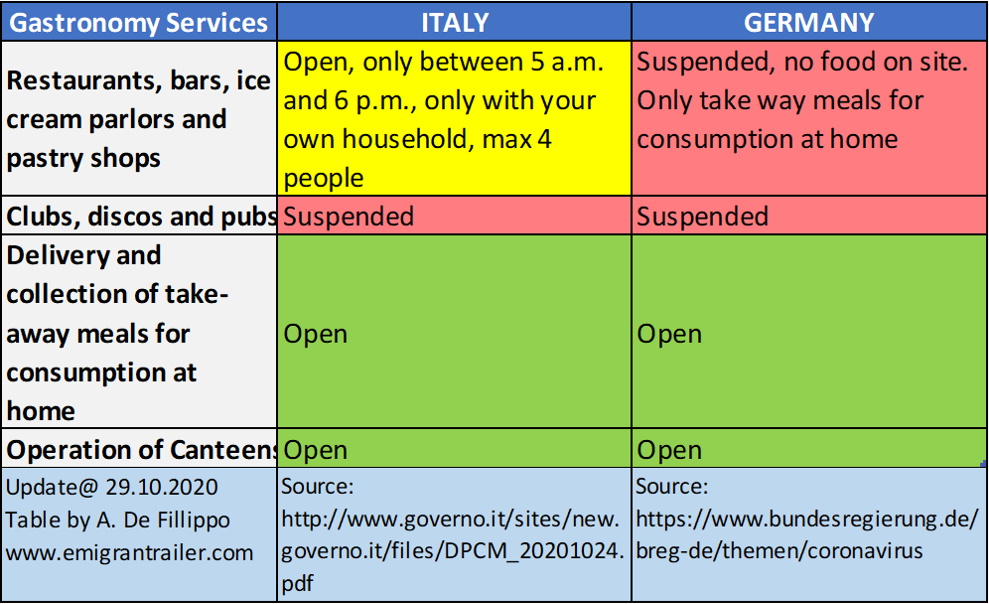
The last table (Table 6) displays the situation for other services. Both governments have suspended all activities in the personal care sectors, while keep open all services for medically necessary treatment, such as physiotherapy. Hairdressing salons and wholesalers, retailers, supermarkets, remain open subject to hygiene and distance requirements, which can be different from previous ones.
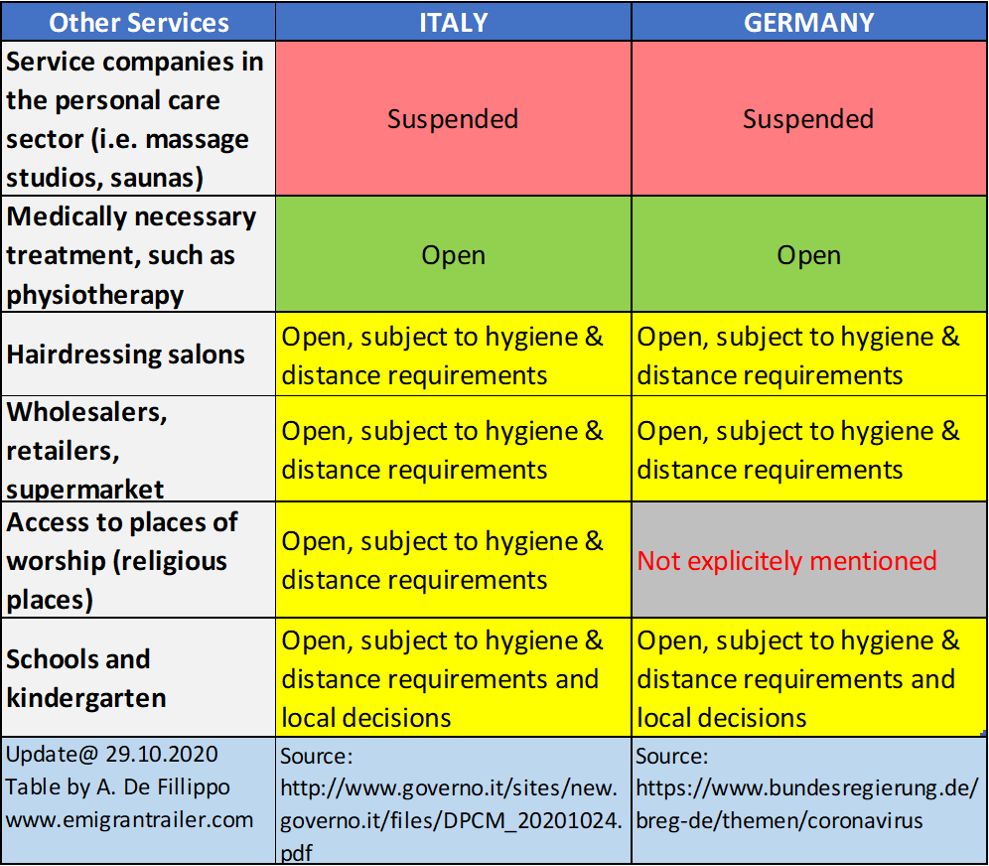
Access to places of worship (religious places) remains open in Italy with certain limitations regarding the presence of people, while it is a bit unclear the direction in Germany, since it was not explicitly mentioned.
Schools and kindergarten remain open, but in both countries, it seems that each local or regional government can eventually decide on additional restrictions, when the situation is considered more critical.
Beyond the presented table and relative content, it is also important to underline that both Italian and German government have also confirmed that they will grant extraordinary economic aid to compensate all companies, businesses, self-employed activities, association and institutions affected by the temporary closings, for the financial losses of this period.
Summing up, both countries have just applied stricter rules to limit the increasing rate of positives cases and to avoid the collapse of the hospital facilities. This is good and necessary, given these boundary conditions.
However, I still miss a clear plan with solutions to live with the virus, without stopping occasionally certain activities. All European governments should have already prepared something in the former weeks (between June and August), where the situation was still under control.
Few days ago, I was very critical about the decisions of the Italian government. And today I am about the German one (which, as positive remark, at least sets a clear parameter to be reached in order to remove the new restrictions).
In conclusion, it is true that we are facing a global pandemic, but it is hard to perpetually accept an approach based simply on closures. In my opinion, without concrete proposals to strengthen the areas most at risk of collapse, we take a path to failure. For for this generation. For the next generation.
Stay healthy!
Andrea De Filippo
p.s. below both links to read the complete infomation about Italian and German rules:
- Italy: http://www.governo.it/sites/new.governo.it/files/DPCM_20201024.pdf
- Germany: https://www.bundesregierung.de/breg-de/themen/coronavirus
_______________________
Other post and analysis about COVID-19 at link: COVID-19 (Corona Virus) | EmigranTrailer



